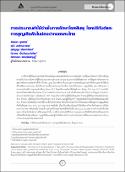บทคัดย่อ
การศึกษานี้มีวัตถุประสงค์หลักเพื่อประเมินภาระของโรคในช่องปากของคนไทย โดยใช้แนวคิดของการศึกษาต้นทุนความเจ็บป่วย การวิเคราะห์ใช้ประมาณการความชุก (prevalence based) ของโรคในช่องปาก จากข้อมูลการสำรวจสภาวะสุขภาพช่องปากแห่งชาติครั้งที่ 8 ปี พ.ศ. 2560 ในการศึกษานี้ประมาณการเฉพาะต้นทุนทางตรงซึ่งคำนวณจากค่าใช้จ่ายที่ต้องใช้อย่างเหมาะสม เพื่อให้ประชาชนทั้งหมดปราศจากโรคฟันผุ โรคปริทันต์และการสูญเสียฟัน ผลการศึกษาพบว่า ประชาชนไทยมีความชุกของโรคฟันผุร้อยละ 45.0 โรคเหงือกและโรคปริทันต์อักเสบร้อยละ 74.5 และ 15.7 ตามลำดับ และจำเป็นต้องใส่ฟันเทียมร้อยละ 31.4 หากต้องทำการรักษาตามความจำเป็นทั้งหมดจะมีค่าใช้จ่ายรวมเป็นมูลค่า 156,925.1 ล้านบาท คิดเป็นร้อยละ 1 เมื่อเทียบกับ GDP จำแนกเป็นการรักษาผู้ที่มีโรคฟันผุุ 28.7 ล้านคน ผู้ที่มีปัญหาโรคเหงือกอักเสบ 47.6 ล้านคน ผู้ที่มีปัญหาโรคปริทันต์อักเสบ 10.0 ล้านคน และผู้ที่มีปัญหาการสูญเสียฟันที่จำเป็นต้องใส่ฟันเทียมถอดได้ 20.1 ล้านคน โดยสัดส่วนภาระค่าใช้จ่ายเพื่อรักษาโรคฟันผุ โรคเหงือกอักเสบ โรคปริทันต์และการฟื้นฟูจากการสูญเสียฟัน คิดเป็นร้อยละ 31.6, 15.8, 11.2 และ 41.4 ตามลำดับ เมื่อเปรียบเทียบต้นทุนค่าใช้จ่ายในการรักษาโรคในช่องปากกับโรคเบาหวาน โรคทางเดินหายใจ โรคมะเร็ง และโรคหัวใจและหลอดเลือด คิดเป็น 36.8, 22.5, 6.5 และ 4.4 เท่า ตามลำดับ โดยสรุปการรักษาโรคในช่องปากมีต้นทุนสูง ดังนั้น การจัดหาเทคโนโลยีที่ประชาชนดูแลตนเองได้เพื่อป้องกันโรคฟันผุและโรคปริทันต์ที่ไม่ซับซ้อนเพื่อลดการสูญเสียฟันและต่อสู้กับปัจจัยการค้ากำหนดโรคในช่องปากที่มีผลกระทบต่อประชากรในวงกว้างจะช่วยลดค่าใช้จ่ายโดยรวมได้
บทคัดย่อ
The aim of this study was to estimate the cost burden of dental diseases among Thai people using
the cost of illness concept. Prevalence of oral illnesses was estimated from the 8th National Oral Health
Survey in 2017. This study assessed only direct costs for treating dental caries, periodontal diseases, and
tooth loss to the entire population. The study’s results showed that 45.0 percent of Thai citizens had
dental caries, 74.5 percent had gingivitis, 15.7 percent had periodontitis, and 31.4 percent required
dentures. A total of 156,925.1 million baht, or 1% of GDP, would be required if all essential treatments
were provided. There were 28.7 million individuals who needed dental caries treatments, 47.6 million
gingivitis treatments, 10.0 million periodontitis treatments, and 20.1 million who required removable
dentures for dental losses. Dental caries, gingivitis, periodontitis, and tooth loss accounted for 32.9%,
15.3%, 10.9%, and 40.8% of the total costs, respectively. Oral diseases were 36.8, 22.5, 6.5, and 4.4 times
more expensive to treatment than diabetes, respiratory conditions, cancer, and cardiovascular disorders,
respectively. In summary, the cost of treating these oral diseases was high. Therefore, self-managed
technology to prevent dental caries and periodontal diseases to reduce tooth loss and measures to
mitigate commercial determinants of oral disease across the population would lower overall treatment
costs.


